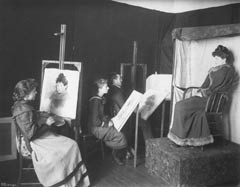Berkeleyan
The ‘Athens of the West’
Latest Chronicle of UC edition highlights history of campus arts and culture
![]()
| 20 October 2004
A Harvard friend of the late Clark Kerr once said — to express his low esteem for the state of culture on America’s far western shore — that he was visiting Berkeley in order to see, from the point of view of an Athenian, how things were done in Sparta. The editors of the Chronicle of the University of California retell this anecdote (and seek to rebut its assumptions) in the newly released sixth edition of the journal, whose theme is the history of arts and culture at UC.
Organized chronologically, the edition begins with Berkeley’s class of 1894, which staged a medieval-based ceremony in what became known as Ben Weed’s amphitheater, named for the student who scouted out the bowl-shaped grove of eucalyptus trees on the campus’s eastern edge. Less than a decade later, the rustic site was transformed into a classical Greek amphitheater hailed at the time by the San Francisco Chronicle as “the noblest theatre the world has seen since the days when Greeks were Greeks.” The Hearst Greek Theatre, of course, went on to be a world-class venue for Greek drama, Italian opera, Sanskrit classic drama, and popular music from the Grateful Dead to REM.
The new issue of the Chronicle offers an historical account of artistic and cultural instruction, performance, and scholarship at Berkeley — with articles on, among other subjects, the history of visual arts, exhibition spaces, the annual spring dance concert, the Shakespeare performance program, the Berkeley Art Museum, and the Pacific Film Archive. (In theory the journal treats the entire UC system; in practice, so far, it covers the flagship campus primarily.)
 Women art students perfect their portrait skills at the Mark Hopkins Institute in in 1894, shortly after the Nob Hill mansion became part of the University of California. (University Archives photo) |
The institute’s role in UC art instruction and exhibition was short-lived, however. The Nob Hill mansion burned after the 1906 earthquake, and it was not until 1923 that art practice was first taught on the Berkeley campus itself.
Also found in the Chronicle’s art and culture issue — amply illustrated by by historical photos and graphics — is “The Lure of the Exotic,” a long piece by the Hearst Museum’s Ira Jacknis, based on research conducted over nearly 15 years. In it the research anthropologist recounts the history of a “vanished department” that, between 1912 and 1979, went by a variety of names — Household Art, Decorative Art, then Design — and of its status, in the first half of the 20th century, as a national center for the study of basketry and textiles.
Another entry, by Maryly Snow, head of the campus’s Architectural Visual Resources Library, traces the history of that collection. “I had a fabulous time doing the research and discovering how people find things that get lost,” Snow said at a reception last week to celebrate the new issue. The “lost things” she discovered at UC’s Northern Regional Library Facility, in Richmond, were 32 lantern slides that the architectural giant John Galen Howard had used to illustrate his 1905 architectural history lectures. By matching them up with a verbatim transcript of his lectures, found in the University Archives, Snow said, “it should be possible to compare the way architectural history was taught then and now.” Her piece traces the evolution of the visual library — its shifting fortunes, “relentless internecine classification battles,” and the transformation of technologies for reproduction, storage, and display (down to current presentation of digitized images on the Internet).
Earlier installments of the Chronicle covered campus disasters, women at Cal, the university and the environment, UC in 1900 and 2000, and conflict and controversy at the university. Upcoming issues will be called “Changing Places: Californians Abroad, Visitors Here” and “Agriculture, Viticulture, and Gastronomy.” Articles for those issues are still being solicited. For information on the Chronicle of UC or to subscribe ($20 for single copies, $36 for two issues), see sunsite.berkeley.edu/uchistory/chronicle or call Caroll Brentano at 643-9210.

